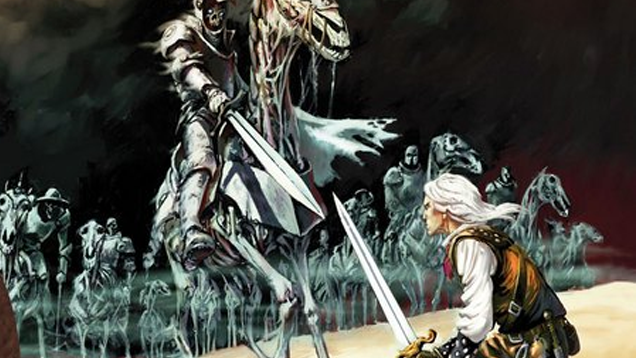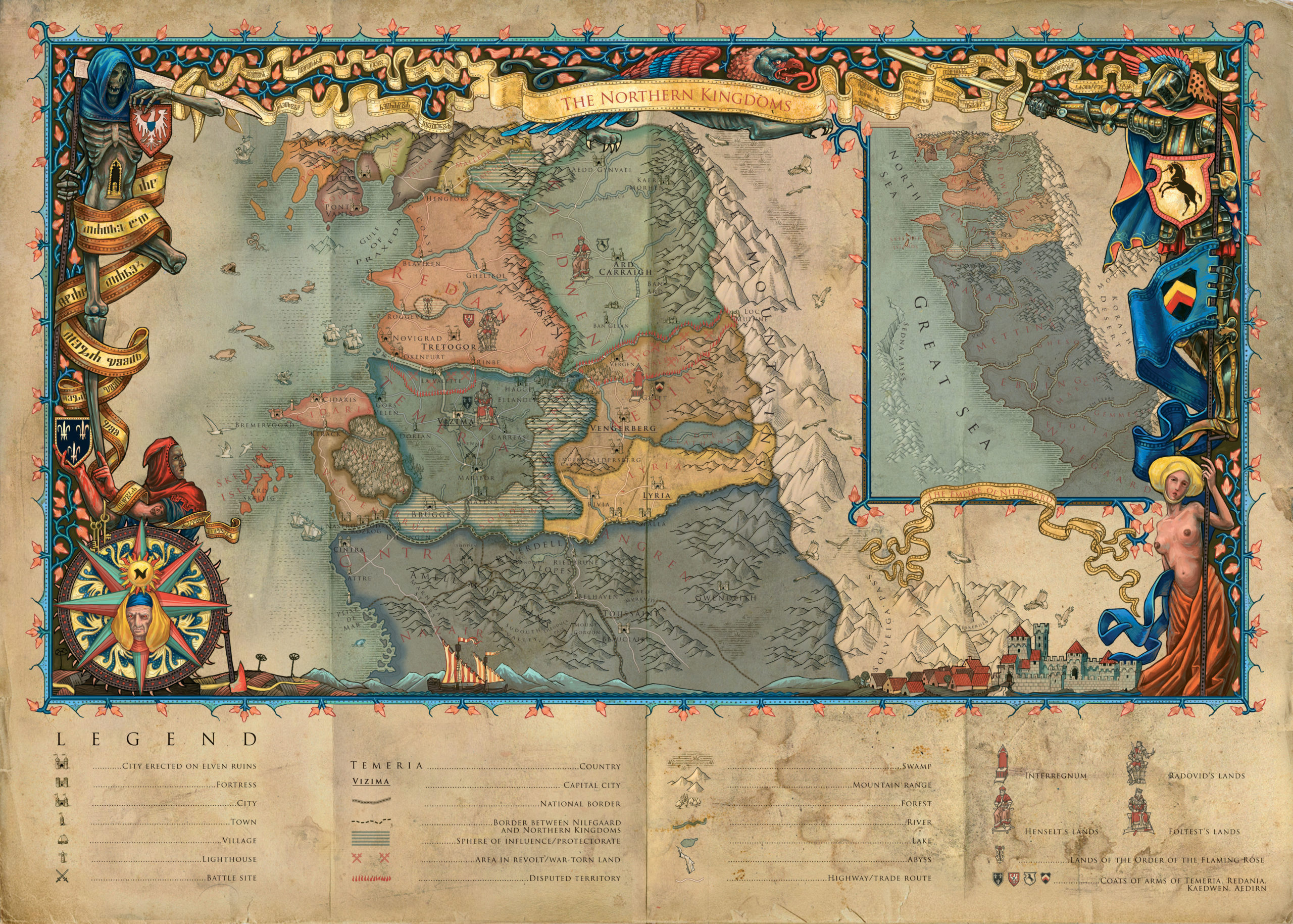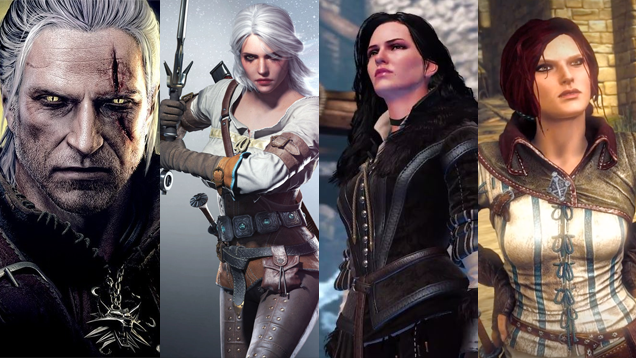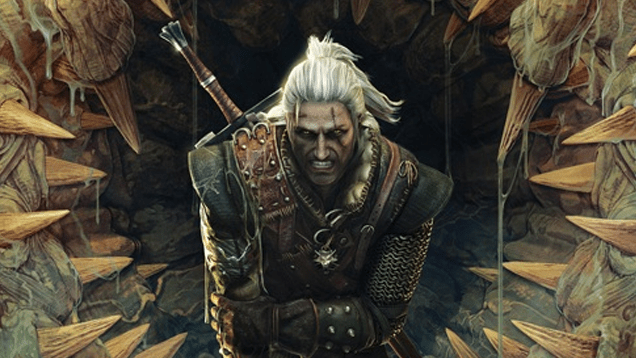If you play video games, you might be familiar with The Witcher. But before Geralt of Rivia dazzled gamers in CD Projekt Red’s series, he was the star of Polish writer Andrzej Sapowski’s hit fantasy novels. Want to know more about the literary origins of the Witcher? Here’s everything you need to get started.
Origins

Although English-speaking familiarity with The Witcher books has only largely come about due to the success of the Witcher video games, they have actually been around since the early 90’s. The first stories set in the Witcher universe — dubbed Wiedźmin in Polish — were written by Andrzej Sapkowksi for the Polish science fiction and fantasy magazine Fantastyka (in fact, Sapkowski wrote the very first short story for a competition for the magazine in the mid 1980s), where many premiere Polish writers of science fiction and fantasy cut their teeth.
After gathering the short stories into two anthologies, Sapkowski decided to begin a proper series of novels in the world he created, which saw the writer explode in popularity in his native Poland. The novels slowly got translated for readers in other Eastern European countries, propelling the books to a cult following. But despite their relative success in Poland, the novels largely remained cult classics in mainland Europe.
It would take the release of CD Projekt Red’s The Witcher in 2007 to spark interest in the U.K. and America. The growing popularity of the games, culminating in the release of the third game in the series (as well as the first ever translation of the second set of short stories) this week, has led to the translation of the novels for English-speaking audiences in the last few years.
How To Read The Witcher
The Witcher novels can be split into two sets: the original short stories, collected in two anthologies, and the novels themselves, dubbed the “Blood of Elves” saga. Here’s the reading order, starting with the short stories:
- The Last Wish (Written in 1993, Translated in 2007)
- The Sword of Destiny (Written in 1992 — but chronologically takes place after the first anthology — Translated in 2015)
- The Blood of Elves (Written in 1994, Translated in 2009)
- Times of Contempt (Written in 1995, Translated in 2013)
- Baptism of Fire (Written in 1996, Translated in 2014)
There are two additional novels in the series currently untranslated: Wieża Jaskółki (The Tower of the Swallow, first released in 1997) and Pani Jeziora (The Lady of the Lake, first released in 1999). They will be getting official English translations in 2016 and 2017 respectively.
The games themselves are set in the universe of the Witcher, but actually take place several years after the events of the entire Blood of Elves saga. Geralt begins the first game as an amnesiac, not remembering the events that take place in the novels. Our sister site Kotaku recently posted a pretty comprehensive guide to the events of the first two games, The Witcher and The Witcher 2: Assassin of Kings, if you want to check out what happens after the books.
What The Hell Is A Witcher?

The Witcher isn’t just the title of the series, it’s protagonist Geralt’s occupation. 1,500 years before the events of The Last Wish, a cataclysmic event known as the “Conjunction of the Spheres” occurred, bringing various monsters and supernatural creatures like vampires and werewolves to The Continent (more on that later). As monsters began attacking citizens, the need for a defence force led to the creation of The Witchers: Men (and very rarely women) trained from a young age in martial skills to battle monsters.
During their training, Witcher candidates are exposed to mutagens that grant them enhanced strength, agility and an extended lifespan, as well as the basic ability to use magic. The downside of the mutation process is that Witchers are left sterile by the process, meaning new Witchers have to be recruited — into one of three training academies: The School of the Wolf, The School of The Cat, and The School of the Griffon — rather than being born through Witchers procreating together.
To aid in recruitment, the Law of Surprise was introduced. In return for a favour or a contracted job (Witchers by their very nature are mercenaries, answering to no Kingdom or country), instead of a monetary reward, a Witcher can claim one of two things: “The first thing that comes to greet you” (such as a guardsmen at the gate, or an animal), or “What you find at home yet don’t expect”. The latter is usually invoked as the Law, as it often refers to an unborn child, who the Witcher can then conscript into their order when they come of age. This Law, combined with The Witchers propensity for magic, makes them unpopular with many people on the Continent, despite their role as protectors.
Fun fact: Originally, Sapkowski preferred the English translation of the original Polish wiedźmin as “The Hexer” — and in fact, when a movie loosely based on the books was released with international subtitles in 2001, Geralt was referred to as a Hexer in the translation. It wouldn’t be until the first CD Projekt Red game decided to translate the word as “Witcher” that the name caught on — Witcher would be used in the English translations to capitalise on the game’s success, and then Sapkowski himself began using the term to refer to the series.
Welcome To The Continent

The Witcher novels take place in an unmapped land known as The Continent (although Sapkowski has consulted on several maps to use in the video games, like the one above). Thousands of years before the existence of Humanity, Elves colonised the continent — then populated by gnomes and dwarves — following a short war between the three races, but the cataclysm that brought about the presence of monsters forced these races into relative peace. Humans are relative newcomers to the land, having only been around for roughly 500 years before the events of the first book, but they soon made war with the other races and became the dominant species of The Continent.
Politically, The Continent is split into two factions: a loosely allied series of Kingdoms in the North (helpfully known as the Northern Kingdom), and the southern-based Nilfgaard Empire, who are constantly at war: The Last Witch is set shortly after a war between the two powers, and a second breaks out during the events of Times of Contempt.
A Few Key Characters

Although the world of The Witcher is populated by a vast cast of characters, the books revolve around four particularly important ones: Geralt, Ciri, and the sorceresses Yennefer and Triss.
Geralt of Rivia
Geralt is the protagonist of the Witcher saga, and considered to be one of the most powerful Witchers ever — he even encouraged the Witchers to experiment with advanced mutagens on him during training, draining his skin and hair of colour and giving him the nickname “White Wolf”. A professional Witcher, Geralt loathes involvement in politics (a popular stance in ’90s Poland), instead choosing to head out into The Continent and offer his services as a mercenary and monster for hire.
Ciri
While under the employment of her parents, the King and Queen of Cintra, Geralt invoked the Law of Surprise as payment for his services, claiming the then unborn Ciri for Witcher training. However Geralt didn’t collect the child when she came of age, and after her parents were lost at sea, Ciri was orphaned.
Ciri eventually came across Geralt later in her life after being adopted by a Merchant Geralt was hired by, and the Witcher then decided to take her in for training. Ciri did not go through the mutation process as other Witchers did. Instead, after discovering she also had a natural talent for magic, she was also trained as a powerful sorceress and goes on to play a incredibly key role in the novels and the third Witcher game.
Yennefer of Vengerberg
A powerful magic user introduced in The Last Wish, Yennefer is also Geralt’s lover. Born with both human and elven blood, Yennefer was a natural magic user, becoming a sorceress as a young age. As with Witchers, magic use causes the caster to become sterile, so while Yennefer and Geralt could never have children, they essentially adopted Ciri as their own.
In the world of the Witcher, Sorceresses are also infamous for their use of magical glamours to make themselves appear beautiful and extend their life. Yennefer, who is nearly 100 during the books, uses her magic to appear as one of the most beautiful people in the Northern Kingdoms (as well as to hide her hunchback, a deformity only Geralt knows after seeing through her glamour in The Last Wish).
Triss Merigold
In the novels, Triss is a sorceress and close friend to Geralt and Yennefer (and harbours unrequited feelings for Geralt), and becomes a sister figure to Ciri as she begins her training in magic. Her role is much more minor in the Witcher saga compared to the role in the Witcher video games, where she is one of the first people Geralt meets after becoming an amnesiac. Over the course of the games a love triangle forms between Triss, Geralt and Yennefer — who appears in the series for the first time in The Witcher 3 — something that doesn’t actually play out in the novels.

Comments
13 responses to “How To Get Into The Witcher Novels”
Excellent.
I loved the first two games and went a search to track down the books. Locally. Could have gone the Amazon/etc route but hey it was like a quest from the game for me what of it. Currently I’ve got Last Wish and Blood of Elves. Thumbing through them, it seems like they read more like what the games would call ‘contracts’ or sidequests. That’s not a bad thing, though.
Currently, I’m knee-deep in Witcher 3 and the loading screen narrations still mention what I did in the Bloody Baron quest.
I take it the game thinks I’m only half-way finished? My question for anybody who’s played through or is more of an expert than me is what do I *need* to focus on? I’ve reached Level 17, checked out Skellige a little bit after the funeral but not really loving it. Novigrad is where my favourite characters (from the games) are and it’s big and varied…..but I’m still weak-sauce to do these quests.
What do?
I’m currently playing through TW3 too. Loading screens seem to be all over the place. Which one I get seems to depend what place I fast travel too.
Exploring Skellige is hell. 80% of the points of interest on the map are underwater chests. Sidequest wise there’s a few interesting ones. Helping Crach’s kids is probably the most important of things to do.
What difficulty are you playing on? I’m on normal and have been able to easily do quests 10 levels above my level by just spamming dodge and light attack.
You probably are only half-way! It’s a massive game.
Keep going with Skellige, it gets much better. To be honest I vastly preferred the Skellige main quest line to the Novigrad one.
If you want to level up quickly (so you can use those sweet ass Witcher crafting blueprints), then focus on story missions. However, I’d recommend taking the time to do as many side quests as you can – especially the Witcher Contracts.
And then, once you’re done with the main game, get both DLCs. Hearts of Stone has one of the best video game villains I’ve come across in a long time, and Blood & Wine is big enough to be its own game (hell, it IS bigger than a lot of modern AAA games).
Currently lvl 60 in Velen for new game +. Stick with Skellige as Dire Wolf said. Dont forget that you can use boats to fast travel when needed. Ignore most of the points of interest that are in the middle of the water, you can come back for them later (and you will need to if you get Blood and Wine, that DLC drains gold).
If you are on one of the two easy difficulties then tackling side quests a few lvls above yours isnt too hard and gives extra exp. Just make sure you are within 6 levels of the main quest suggested lvl or you wont be rewarded with the full amount of exp.
Most important: stop and look around once and a while. This game is beautiful and breathtaking and it doesnt hurt to just watch the sun rise now and then
I highly recommend the audiobooks of the series, narrated by Peter Kenny, too. I’m up to Baptism of Fire, after many many hours of commuting, and it’s been so entertaining and so well narrated.
Tower of the Swallow is translated into English now
It’s also missing a reference to Season of Storms, a prequel that came out a couple of years ago, as well as two Witcher-related short stories.
Fan translations are out for all of the above (and Lady of the Lake) and are decent enough to get the job done.
The Last Wish gave me better context, especially as TW3 is the only installment I’ve played, especially around Geralt and Yen’s relationship. What I assume derives in some ways from European myth and folklore really gives this world amazing depth.
I’ve been really impressed with the quality of CD Projekt Red’s work, including the DLC; I’m looking forward to Cyberpunk 2077.
I feel like the Witcher books are kinda giving diminishing returns as the series goes on. They’re enjoyable early on, but get less focused and more distracted by supporting characters and politics as they go along.
Going on a long trip soon. I think it’s in my best interests to buy some books.
Don’t sorceresses and mages look like they do because they’ve used magic to physically transform themselves, not create an illusion? And I thought witchers were all men because women couldn’t survive the Trial of the Grasses.
I could be wrong though, I’ve only read The Last Wish and that was a long time ago.
Geralt was all set to run Ciri through the Trial of Grasses. The issue was more that most people, regardless of gender, don’t survive the Trial of Grasses.
The Tower of Swallows actually came out a few months ago. Do your research if you’re going to write a long article about the books. Come on now lol.